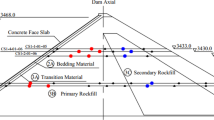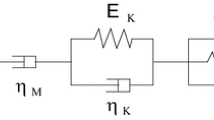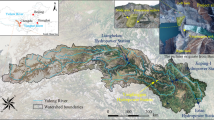Abstract
Considering the complex nonlinear relationship between the material parameters of a concrete faced rock-fill dam (CFRD) and its displacements, the harmony search (HS) algorithm is used to optimize the back propagation neural network (BPNN), and the HS-BPNN algorithm is formed and applied for the inversion analysis of the parameters of rock-fill materials. The sensitivity of the parameters in the Duncan and Chang’s E-B model is analyzed using the orthogonal test design. The case study shows that the parameters φ 0, K, R f , and K b are sensitive to the deformation of the rock-fill dam and the inversion analysis for these parameters is performed by the HS-BPNN algorithm. Compared with the traditional BPNN, the HS-BPNN algorithm exhibits the advantages of high convergence precision, fast convergence rate, and strong stability.
Similar content being viewed by others

References
Huang W X, Ren Q W, Sun D A. A study of mechanical behavior of rock-fill materials with reference to particle crushing. Sci China Ser E-Tech Sci, 2007, 50: 125–135
Luo X Q, Ge X R. Research on Stress and Strain Analysis Method of Concrete Face Rock-Fill Dam (in Chinese). Beijing: China Water Power Process, 2007
Ma H Q, Cao K M. Key technical problems of extra-high concrete faced rock-fill dam. Sci China Ser E-Tech Sci, 2007, 50: 20–23
Li Z C, Gu C S, Wang Z Z, et al. On-line diagnosis method of crack behavior abnormality in concrete dams based on fluctuation of sequential parameter estimates. Sci China Tech Sci, 2015, 58: 415–424
Kavanagh K T, Clough R W. Finite element applications in the characterization of elastic solids. Int J Solids Struct, 1971, 7: 11–23
Lee I M, Kim D H. Parameter estimation using extended Bayesian method in tunneling. Comput Geotech, 1999, 24: 109–124
Su H Z, Li J, Wu Z R. Feedback analysis for mechanical parameters of dam and its foundation with optimization algorithm (in Chinese). J Hydraul Eng-ASCE, 2007, 10: 129–134
Liu S F, Qin J. Improved particle swarm optimization algorithm- based inverse analysis on parameters for permeability coefficient (in Chinese). Water Resour Hydropower Eng, 2015, 46: 119–122
Li D Y, Gan X Q, Zhou W. Back analysis on mechanical parameters of dams based on uniform design and genetic neural network (in Chinese). Chin J Geotech Eng, 2007, 29: 125–130
Wang X, Kang F, Li J J, et al. Inverse parametric analysis of seismic permanent deformation for earth rock-fill dams using artificial neural networks. Math Probl Eng, 2012, 29: 1–19
Yu Y Z, Zhang B Y, Yuan H N. An intelligent displacement back analysis method for earth-rockfill dams. Comput Geotech, 2007, 34: 423–434
Li B J, Cheng C T. Monthly discharge forecasting using wavelet neural networks with extreme learning machinev. Sci China Tech Sci, 2014, 57: 2441–2452
Geem Z W, Kim J H, Loganathan G V. A new heuristic optimization algorithm: Harmony search. Simulation, 2001, 76: 60–68
Duncan J M, Chang C Y. Nonlinear analysis of stress and strain in soils. J Soil Mech Found Div, ASCE, 1970, 96: 1629–1653
Zheng D J, Cheng L, Bao T F, et al. Integrated parameter inversion analysis method of a CFRD based on multi-output support vector machines and the clonal selection algorithm. Comput Geotech, 2013, 47: 68–77
Georgiou S D. Orthogonal designs for computer experiments. J Stat Plan Infer, 2011, 141: 1519–1525
Su L S, Zhang J B, Wang C J, et al. Identifying main factors of capacity fading in lithium ion cells using orthogonal design of experiments. Appl Energ, 2016, 163: 201–210
Qian J H, Yin Z Z. Theory and Calculation of Soil Engineering (in Chinese). Beijing: China Water Power Process, 1996
Li S D, Yu H L. Modification of Goodman interface element (in Chinese). Chin J Rock Mech Eng, 2004, 23: 2628–2631
Song Z Y. Research on methods for dam safety monitoring based on intelligence computation. Dissertation for the Doctor Degree. Dalian: Dalian University of Technology, 2007
Xu C, Ye G B. Parameter sensitivity analysis of numerical model by cross test design technique. Hydrogeol Eng Geol, 2004, 1: 95–97
Kang F, Li J J, Xu Q. Ant colony clustering radial basis function network model for inverse analysis of rockfill dam (in Chinese). Chin J Geotech Eng, 2009, 28: 3639–44
Chua C G, Goh A T C. A hybrid Bayesian back-propagation neural network approach to multivariate modeling. Int J Numer Anal Met, 2003, 27: 651–667
Chen A G, Ye J W. Research on four-layer back propagation neural network for the computation of ship resistance. In: International Conference on Mechatronics and Automation, Changchun, 2009. 2537–2541
Yu L, Wang S Y, Lai K K. Forecasting foreign exchange rates with an improved back-propagation learning algorithm with adaptive smoothing momentum terms. Front Comput Sci Chi, 2009, 3: 167–176
Yadav P, Kumar R, Panda S K, et al. An intelligent tuned harmony search algorithm for optimization. Inform Sciences, 2012, 196: 47–72
Zhang L P, Xu Y H, Xu G H, et al. A catfish effect inspired harmony search algorithm for optimization. Int J Nonlin Sci Num, 2013, 14: 413–422
Zhou M S, Li Y Q, Xiang Z H, et al. A modified extended Bayesian method for parameter estimation. Tsinghua Sci Technol, 2007, 12: 546–553
Valian E, Tavakoli S, Mohanna S. An intelligent global harmony search approach to continuous optimization problems. Appl Math Comput, 2014, 232: 670–684
Swagatam D, Arpan M, Anwit R, et al. Exploratory power of the harmony search algorithm: analysis and improvements for global numerical optimization. Browse J Magaz, 2011, 41: 89–106
Zhang L, Zhang G, Wang F Q, et al. Rheological deformation backanalysis for Gongboxia concrete-faced rock-fill dam (in Chinese). Rock Soil Mech, 2011, 32: 521–525
Author information
Authors and Affiliations
Corresponding author
Rights and permissions
About this article
Cite this article
Sun, P., Bao, T., Gu, C. et al. Parameter sensitivity and inversion analysis of a concrete faced rock-fill dam based on HS-BPNN algorithm. Sci. China Technol. Sci. 59, 1442–1451 (2016). https://doi.org/10.1007/s11431-016-0213-y
Received:
Accepted:
Published:
Issue Date:
DOI: https://doi.org/10.1007/s11431-016-0213-y



